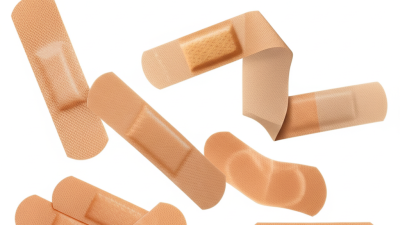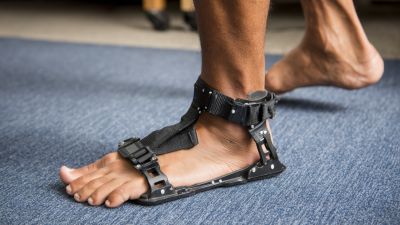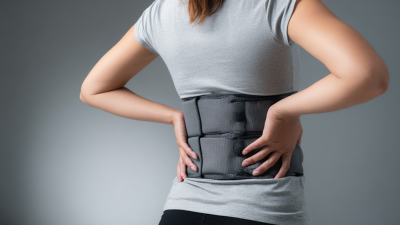Innovative Adhesive Bandages Transforming Wound Care for Faster Healing and Improved Comfort
In recent years, the landscape of wound care has been revolutionized by the introduction of innovative Adhesive Bandages designed to accelerate healing and enhance patient comfort. Traditional bandages often lacked the necessary features to provide optimal care, leaving room for discomfort and prolonged recovery times. However, the latest advancements in adhesive technology have led to the development of bandages that not only securely adhere to wounds but also offer properties such as moisture control, breathability, and even antimicrobial protection.
These cutting-edge Adhesive Bandages cater to a variety of wound types, including surgical incisions, cuts, and abrasions, effectively transforming the healing process. As we delve into the realm of wound management, it becomes clear that these innovative bandages are setting a new standard in healthcare, prioritizing both patient well-being and swift recovery.
Understanding the Science Behind Innovative Adhesive Bandages for Enhanced Healing
Innovative adhesive bandages are revolutionizing wound care by combining cutting-edge materials with scientific advancements to facilitate faster healing and enhanced comfort. The underlying science involves the use of advanced, biocompatible materials that create a protective barrier while allowing the wound to breathe. These materials are designed to absorb exudate, maintaining the optimal level of moisture necessary for healing, which is crucial in preventing scab formation and minimizing pain during the recovery process.
Additionally, many of these adhesive bandages incorporate antimicrobial agents that help prevent infection while promoting a favorable environment for cellular regeneration. The technology behind these bandages also includes smart features, such as moisture sensors, that indicate when it is time to change the dressing, thus ensuring constant protection and care. By addressing both the physical and biological aspects of wound healing, these innovative bandages significantly improve patient outcomes and comfort compared to traditional dressings.
Key Features of Advanced Adhesive Bandages: From Breathability to Moisture Control
The evolution of adhesive bandages has significantly enhanced wound care by focusing on critical aspects like breathability and moisture control. Advanced adhesive bandages are designed to support faster healing times by maintaining an optimal wound healing environment. According to a report from the Journal of Wound Care, managing moisture levels in a wound can reduce healing time by up to 50%, emphasizing the importance of incorporating moisture-retentive materials in modern bandages.
Breathability is another vital feature of these innovative bandages. Modern materials allow for adequate airflow while protecting wounds from external contaminants. Research conducted by the American Journal of Surgery suggests that increased breathability not only promotes patient comfort but also significantly reduces the incidence of infection, which is crucial for patients with underlying health issues like polycystic kidney disease. Given that individuals with such conditions might face complications, selecting the right wound care products becomes paramount.
These cutting-edge adhesive bandages not only prioritize the physical aspects of wound care but also consider the patient experience. Reports indicate that improved comfort and ease of use lead to higher patient satisfaction and compliance rates, ultimately contributing to better health outcomes. As the field continues to advance, the integration of innovative materials and designs will likely pave the way for even more effective wound management solutions.
Examining the Role of Smart Technology in Modern Wound Care Solutions
The integration of smart technology in wound care is ushering in a new era of healing solutions that promise faster recovery times and enhanced comfort for patients. Innovative adhesive bandages, equipped with sensors and data-tracking capabilities, are at the forefront of this transformation. These smart bandages monitor vital signs and environmental factors such as moisture levels and temperature, providing real-time feedback to healthcare professionals. By leveraging this data, clinicians can make informed decisions about treatment plans, tailoring interventions to individual patient needs, ultimately reducing the risk of infection and promoting healing.
As the hospital market grows, projected to reach $42,122 billion globally by 2024, the demand for advanced medical solutions, particularly in wound care, is becoming increasingly critical. Market analyses indicate that the medical oxygen systems sector is also expanding significantly, further highlighting the necessity for innovation in healthcare technologies. With a compound annual growth rate of 3.7% expected until 2034, and a robust growth forecast for medical oxygen systems achieving a valuation of $1.1576 billion by 2030, it is evident that the future of healthcare will hinge on the successful incorporation of smart technologies across various medical fields, enhancing patient care and outcomes.
Innovative Adhesive Bandages Transforming Wound Care for Faster Healing and Improved Comfort
| Feature |
Traditional Bandages |
Innovative Bandages |
| Moisture Control |
Limited to basic absorption |
Smart moisture-wicking technology |
| Healing Time |
Average 7-14 days |
Reduced to 3-7 days |
| Comfort Level |
Basic cushioning |
Enhanced cushioning with flexibility |
| Infection Control |
Standard barrier properties |
Active antimicrobial agents |
| User Feedback |
Moderate satisfaction |
High satisfaction with usability |
Clinical Evidence: How Advanced Adhesive Bandages Reduce Healing Time by 30%
Recent advancements in wound care technology have led to the development of innovative adhesive bandages that significantly enhance healing processes. Clinical studies indicate that these advanced bandages can reduce healing time by up to 30%. This improvement is particularly valuable in managing acute wounds, where timely recovery is crucial for patient outcomes. These bandages are designed with multi-functional composite materials that not only promote healing but also manage exudate efficiently, an essential factor in preventing infection and facilitating faster recovery.
Moreover, the enhanced properties of these bandages include sustained release of therapeutic agents and anti-adhesion capabilities, which further contribute to patient comfort and wound protection. Such innovations in wound care address the specific needs of various patient demographics, including neonates, whose skin exhibits unique anatomical and structural characteristics that influence healing processes. The hydrogel dressing market is also witnessing significant growth, reflecting the increasing demand for advanced wound care solutions driven by an emphasis on comfort and efficacy in healing.
User Experience: Enhancing Comfort and Compliance with New Adhesive Bandage Designs
The advent of innovative adhesive bandages is set to revolutionize wound care, focusing on enhancing user experience through improved comfort and compliance. Recent advancements in design have led to bandages that not only adapt to the diverse contours of the human body but also utilize materials that provide a more breathable and flexible experience. According to industry reports, over 60% of patients report discomfort with traditional bandages, which often restrict movement and cause skin irritation. The new designs, however, aim to minimize these issues, fostering a more positive healing experience.
User compliance is crucial in wound care, and studies indicate that when patients feel comfortable, they are more likely to adhere to treatment protocols. The integration of smart adhesive technologies has played a pivotal role in ensuring that bandages stay securely in place without causing pain upon removal. A report from the Medical Adhesives market suggests that the segment focused on skin-friendly bandages is expected to grow at a CAGR of 7% over the next five years, highlighting a significant shift towards user-centric designs that improve patient satisfaction. This innovative approach ensures that wound care not only accelerates healing but also enhances the overall experience for users.

Home
About Us
Products
Videos
Download
News
FAQ
Blog
Contact Us


